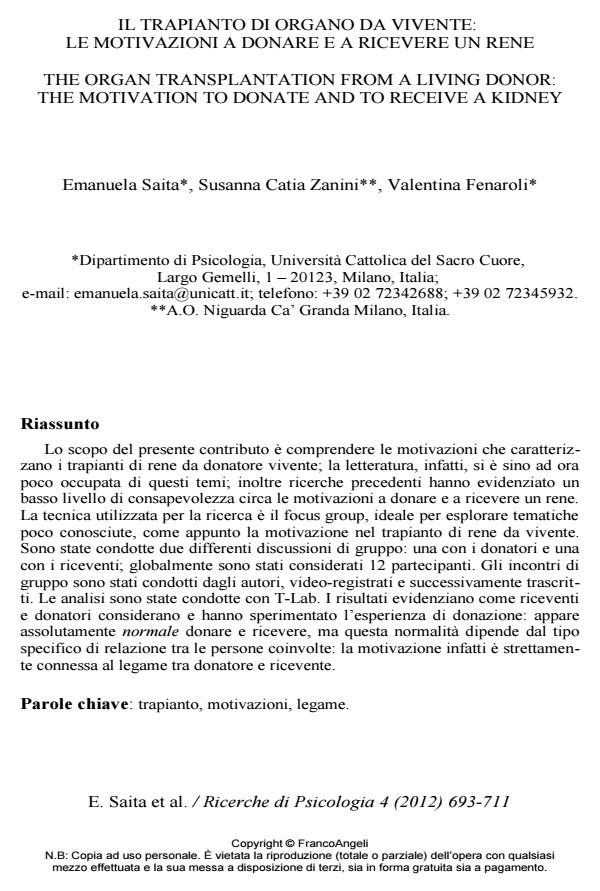The organ transplantation from a living donor: the motivation to donate and to receive a kidney
Journal title RICERCHE DI PSICOLOGIA
Author/s Emanuela Saita, Susanna Catia Zanini, Valentina Fenaroli
Publishing Year 2013 Issue 2012/4 Language Italian
Pages 19 P. 693-711 File size 253 KB
DOI 10.3280/RIP2012-004008
DOI is like a bar code for intellectual property: to have more infomation
click here
Below, you can see the article first page
If you want to buy this article in PDF format, you can do it, following the instructions to buy download credits

FrancoAngeli is member of Publishers International Linking Association, Inc (PILA), a not-for-profit association which run the CrossRef service enabling links to and from online scholarly content.
The aim of this work is to better understand the motivation that distinguish kidney transplantation from living donors because there is a lack in literature regarding this topic and previous researches show a low level of consciousness regarding the motivations to donate and to receive a kidney. The research technic used is focus group, the ideal technic to explore a specific set of unknown issues, such as motivation for kidney transplantation from living. We conducted 2 different group discussions: one with donors and one with recipients, comprising 12 participants. The sessions were conducted by the authors. Each discussion (lasted approximately 2 hours) was video-recorded and then transcribed. The analysis were conducted with T-Lab. The results highlight like previous recipients and donors view and have experienced living donation: they consider absolutely normal to donate and to receive, but this normality depends on the specific kind of relationship between the people involved. In this sense the motivation is strictly connected with the bond between donor and recipient.
Keywords: Transplantation, motivation, bond.
- Engel, G.L. (1980). The clinical application of the biopsychosocial model. The American Journal of Psychiatry, 137(5), 535-544.
- Fellner, C.H., & Marshall, J.R. (1970). Kidney donors: The myth of informed consent. The American Journal of Psychiatry, 126(9), 1245-1251.
- Bodenmann, G. (2005). Dyadic coping and its significance for marital functioning. In K. Kayser, G. Bodenmann, & T. Revenson (Eds.), Couples coping with stress: emerging perspectives on dyadic coping. Washington D.C: APA. Books.
- Fornari, F. (1976). Simbolo e codice. Milano: Feltrinelli.
- Cigoli, V. (1992). Il corpo familiare. Milano: FrancoAngeli.
- Edwards, A., & Elwyn, G. (2009). Shared Decision-Making in Health Care. Oxford: Oxford University Press.
- Engel, G.L. (1977). The need for a new medical model: a challenge for biomedicine. Science, 196(4286), 129-136. DOI: 10.1126/science.847460
- Feltrin, A., Pegoraro, R., Rago., C., Benciolini, P., et al. (2008). Experience of donation and quality of life in living kidney and liver donors. European Society for Organ Transplantation, 21, 466-472. DOI: 10.1111/j.1432-2277.2007.00632.x
- Fukunishi, I., Kitaoka, T., Shirai, T., Kino, K., et al. (2002). Psychiatric Disorders among Patients Undergoing Hemodialysis Therapy. Nephron, 91, 344-347. DOI: 10.1159/000058418
- Fukunishi, I. Sugawara, Y., Takayama, T., Makuuchi, M., Kawarasaki, H. et al. (2001). Psychiatric Disorders Before and After Living-Related Transplantation. Psychosomatics, 42(4), 337-343.
- Lancia, F. (2004). Strumenti per l’analisi dei tesi. Introduzione all’uso di T-LAB. Milano: FrancoAngeli.
- Marewski, J.N., & Gigerenzer, G. (2012). Heuristic decision making in medicine. Dialogues in Clinical Neuroscience, 14(1), 77-89.
- Montanaro, D. (2007). Il trapianto renale da donatore vivente. Udine: Ado-Fvg Informa.
- Reyna, V.F. (2008). A Theory of Medical Decision Making and Health: Fuzzy Trace Theory. Medical Decision Making, 28, 850-865. DOI: 10.1177/0272989X08327066
- Reyna, V.F., & Brainerd, C.J. (1995). Fuzzy-trace theory: An interim synthesis. Learning and individual differences, 7(1), 1-75. DOI: 10.1016/1041-6080(95)90031-4
- Saita, E., & Zanini, S.C. (2010). Donare un rene: le determinanti della scelta. In G. Castelnuovo, A. Menici, & C. Fedi (Eds.), La donazione in Italia. Springer.
- Schover, L.R., Streem, S.B., Boparai, N., Duriak, K., et al. (1997). The Psychosocial Impact of Donating a Kidney: Long-Term Follow up from a Urology Based Center. Clinical Urology, 157(5), 1596-1601. DOI: 10.1016/S0022-5347(01)64803-1
- Schroder, N.M. (2008). Consideration of psychosocial factors in the evaluation of living donors. Progress in Transplantation, 18(1), 41-48.
- Silverman, D. (2002). Come fare ricerca qualitativa. Roma: Carocci.
- Yi, M. (2003). Decision-Making Process for Living Kidney Donors. Journal of Nursing Scholarship, 35(1), 61-66. DOI: 10.1111/j.1547-5069.2003.00061.x
- Health Literacy Emanuela Saita, Susanna Zanini, Enrico Minetti, Chiara Acquati, pp.306 (ISBN:9781522519287)
- Transformative Healthcare Practice through Patient Engagement Emanuela Saita, Susanna Zanini, Enrico Minetti, Chiara Acquati, pp.1 (ISBN:9781522506638)
Emanuela Saita, Susanna Catia Zanini, Valentina Fenaroli, Il trapianto di organo da vivente: le motivazioni a donare e a ricevere un rene in "RICERCHE DI PSICOLOGIA " 4/2012, pp 693-711, DOI: 10.3280/RIP2012-004008